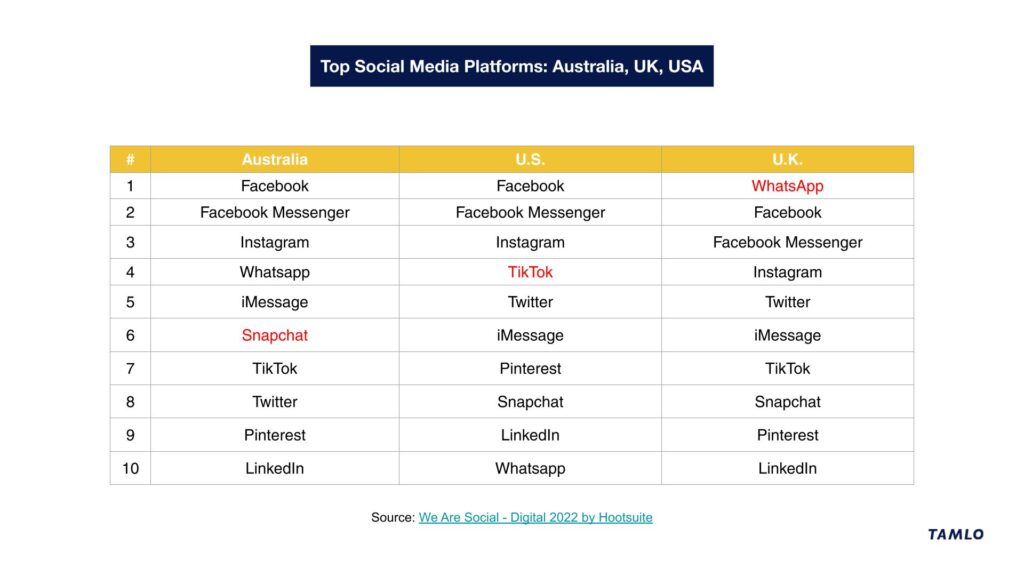Digital & consumer behaviour across the USA, UK, & Australia

The importance of localisation
Localisation may not seem relevant for countries that speak the same language, but that could not be further from the truth. Although the US, UK, and Australian markets all speak English, each comes with its own unique set of behaviours, preferences, and trends. Therefore, your marketing strategy should also be tailored depending on the country– better yet, the specific region.
In this article, we’ll identify differences and similarities in social media usage, internet usage, and consumer behaviour between the UK, USA, and Australia. In turn, this information will help you to better navigate and determine your marketing strategy.
Social media usage across the US, UK, and Australia

Social media usage in the USA
According to Data Reporta’s Digital 2022 Report on the US, around 270 million or 81% of Americans use social media. They mainly use it for connecting with others, reading the news, sharing information, and entertainment. 75% of US internet users aged 16-64 log onto Facebook at least once a month, making it the most popular social platform. Facebook Messenger, Instagram, TikTok, Twitter, and Pinterest are also popular.
According to the same report, YouTube has 247 million users as of early 2022. Its ad reach is 74% of the total population. TikTok, which has 131 million users in the States, reaches over 50% of all adults over 18. Its demographics indicate that it may be a good platform for reaching a female audience, as 62.1% of its American users are female.
Social media usage in the UK
There are 57.6 million active social media users in the UK, which amounts to about 84% of the population according to the Digital 2022 Report. They spend an average of 1 hour and 48 minutes per day on social media. They use an average of 6.3 social media platforms each month. The majority (53.6%) use it to keep in touch with friends and family, while others use it to fill spare time, read the news, or find content.
The most popular social media platform is WhatsApp, with nearly 75% of social media users aged 16-64 using it every month. Close behind is Facebook, with 73.5%. Facebook Messenger, Instagram, and Twitter are also some of the top platforms.
TikTok is on the rise, with more than 21.8 million (31.9% of the population) using the platform. British people spend the most time on TikTok globally, with an average of 27.3 hours per month compared to the global average of 19.6 hours. UK users’ ‘favourite’ social media platforms include Facebook (20.1%), Whatsapp (20.6%), and Instagram (14.6%).
Social media usage in Australia
Data Reportal’s Digital 2022 Report on Australia states that as of February 2022, Australian people spend an average of 1 hour and 57 minutes per day on social media. After television, social media is now the second most popular media activity. It has 21.45 million social media users, roughly 83% of the population.
76.8% of social media users aged 16-64 use Facebook every month, making it the most popular social media platform. Next is Facebook Messenger, with 66.4% of the population, followed by Instagram, Whatsapp, iMessage, and Snapchat. Australians’ ‘favourite’ platforms include Facebook at the top spot, Instagram second, and Facebook Messenger third.
TikTok, Snapchat, and Discord are also some of Australians' favourite platforms. TikTok in particular is getting more popular, with 32% of those aged 16-64 using it. Australians use TikTok for an average of 23.4 hours a month, a 40% increase since 2021.
YouTube is a particularly powerful platform for advertising. In January 2022, YouTube ads reached 90.3% of Australia’s total internet user base. Kid-friendly channel Bounce Patrol is Australia’s most popular YouTube channel with nearly 26 million subscribers. Dancer Hannah Balanay is the country’s most-followed TikToker. 56.1% of Instagram’s ad audience and 55.3% of TikTok’s ad audience were female in early 2022. This indicates that both Instagram and TikTok ads may be good for targeting Australia’s female population.
Key Takeaways
Although there is some overlap across all three nations, there are some key differences in social media usage. Whatsapp is widely used as a messaging app in the UK, while Facebook Messenger is preferred in the US and Australia. TikTok is growing in all three markets.
Search Behaviour

Search behavior in the USA
According to the aforementioned Digital 2022 Report on the US, over 92% of the population uses the internet, spending an average of 7 hours per day across all devices. Mobile takes 49.5% of the share of total internet usage. 72.4% use the internet to find information, 65.1% to research how to do things, 62.1% to stay in touch with friends and family, 58% to watch videos, TV shows, and movies.
The most-visited websites in the US are Google, YouTube, Facebook, Amazon, Wikipedia, Yahoo, Reddit, and Walmart. Google is the dominant search engine, with over 87% of the market share. Bing has 6.4%, Yahoo has 3.3% and Duckduckgo has 2.5% of the market share.
The top search queries include:
- weather
- youtube
- walmart (supermarket chain)
- craigslist (classified ads)
- reddit (forum site)
- NFL (National Football League)
- NBA (National Basketball Association)
- target (department store)
Search behavior in Australia
The Digital 2022 Report on Australia states that Australia’s internet penetration is a little lower, as 91% of the population are internet users. They also spend less time on the internet than Americans, with an average of 6 hours 13 minutes per day. 45.3% of that time is spent on mobile. They mainly use the internet to find information, stay in touch with friends/family, research how to do things, follow the news/current events, watch shows & movies, and research brands.
Top sites include Google, Facebook, YouTube, Wikipedia, News.com.au, bom.gov.au (Bureau of Meteorology), ebay.au, Bitly, and Reddit. Google is also the dominant search engine, with nearly 94% of the market share. Bing takes 4%, while both Duckduckgo and Yahoo have less than 1% of the market share. Top queries in Australia include:
- weather
- news
- bunnings (Australian hardware chain)
- kmart (department store)
- bom (Bureau of Meterology)
- coles (supermarket)
- woolworths (supermarket)
Search behavior in the UK
At 98% of the population, the UK has the highest percentage of internet users of the three countries, according to We Are Social's Digital 2022 Report. They spend an average of 6 hours and 12 minutes per day on the internet, with 43.2% of that time spent on mobile.
Nearly three-quarters use it to find information, 65.6% use it to research how to do things, 63.5% use it to stay in touch with friends/family, 60.6% use it for the news/current events, and 55.9% use it to research brands.
Top websites include Google, YouTube, BBC, Facebook, Hotmail, Amazon, Wikipedia, Bitly, Live (Microsoft Outlook), and the Daily Mail (newspaper). Google and Bing take up most of the search engine market share (92.76% and 4.42%, respectively).
Some of the top queries in the UK are:
- bbc (public broadcaster)
- news
- weather
- tesco (supermarket chain)
- Liverpool
- next (apparel brand)
- asda (supermarket chain)
- argos (merchandise retailer)
- boots (pharmacy)
Key Takeaways
Overall, search engine usage is similar across all three markets but search queries and popular sites tend to differ. For example, Australians search for ‘BOM’ to check out the weather and shop at stores such as Bunnings and Coles that are not available in other countries.
The top websites also overlap in some areas while they are completely different in others. In Australia, news.com.au and bom.gove.au are standouts. In the US, Yahoo and Walmart are unique. Live, BBC, and the Daily Mail are popular in the UK. Also, although internet usage is high across all three countries, Australia lags behind the most.
Consumer behaviour: USA, UK, Australia
Finally, let’s go over consumer behaviour across all three markets.
In the UK, consumers tend to be a bit more pessimistic or pragmatic than Americans, according to Marketing Week. They are also more cautious and are three times more likely to be careful spenders than Americans. Brits also tend to be ‘idea seekers'. Thus, they are more likely to embrace new technology and products that they believe will lead to self-improvement and success.
On the other hand, due to the US’s credit economy, Americans are more likely to spend money even if they don’t have it. The Marketing Week report also notes that Americans are more than five times more likely to be self-confident than Brits and are more affected by emotive advertising.
One report by Attest showed that British consumers are more environmentally conscious. 76% of Brits saying they care about the negative environmental impact of producing cheap, throwaway products and clothing, while only 62% of Americans said the same.
Sustainability is also important to Australians. According to research firm McCrindle, 57% of consumers say they increase engagement with organisations that behave ethically.
This attitude also translates to diet. There are more than twice as many vegetarians and vegans in the UK than in America, according to the aforementioned Attest report. 7% of Americans are vegetarian/vegan versus 17% of Brits. There are other differences in eating habits. 16.5% of Americans like to go out for a meal, while 14% of Brits prefer to get takeaway.
Ecommerce and digital shopping are increasing across all three markets. According to the aforementioned Digital 2022 reports, online food delivery has increased by 34% in 2022 in the UK, with 5 million more people ordering food online than in 2021. Online shopping in Australia saw an increase of 19% in 2021, with more than half of the population buying something online each week. In the US, the National Retail Federation has forecasted that non-store and online sales will grow between 11-13% in 2022.
Another key trend is in the financial industry. According to the US Digital 2022 report, although cryptocurrency is gaining momentum worldwide, this is especially true in the States. 12.7% of American internet users say they own cryptocurrency, compared to 10.2% globally. Podcasts are also continuing to grow, with people listening to an average of 58 minutes daily– an increase of 18.4%.
The secret to success: localisation
No matter how similar any two markets may seem, from a shared language to shared borders, a localised marketing strategy is necessary to achieve any sort of success. If you would like to learn how the localisation and transcreation experts at TAMLO can help with any of your digital or content marketing projects, please do not hesitate to get in touch.





